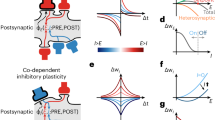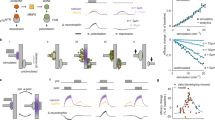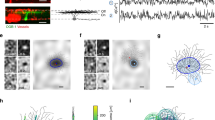Abstract
Theoretical and experimental studies on the computation of neural networks suggest that neural computation results from a dynamic interplay of excitatory and inhibitory (E/I) synaptic inputs. Precisely how E/I synapses are organized structurally and functionally to facilitate meaningful interaction remains elusive. Here we show that E/I synapses are regulated across dendritic trees to maintain a constant ratio of inputs in cultured rat hippocampal neurons. This structural arrangement is accompanied by an E/I functional balance maintained by a 'push-pull' feedback regulatory mechanism that is capable of adjusting E/I efficacies in a coordinated fashion. We also found that during activity, inhibitory synapses can determine the impact of adjacent excitatory synapses only if they are colocalized on the same dendritic branch and are activated simultaneously. These fundamental relationships among E/I synapses provide organizational principles relevant to deciphering the structural and functional basis for neural computation within dendritic branches.
This is a preview of subscription content, access via your institution
Access options
Subscribe to this journal
Receive 12 print issues and online access
$209.00 per year
only $17.42 per issue
Buy this article
- Purchase on SpringerLink
- Instant access to full article PDF
Prices may be subject to local taxes which are calculated during checkout





Similar content being viewed by others
References
Koch, C., Poggio, T. & Torre, V. Nonlinear interactions in a dendritic tree: localization, timing, and role in information processing. Proc. Natl. Acad. Sci. USA 80, 2799–2802 (1983).
Bush, P.C. & Sejnowski, T.J. Effects of inhibition and dendritic saturation in simulated neocortical pyramidal cells. J. Neurophysiol. 71, 2183–2193 (1994).
Ferster, D. & Miller, K.D. Neural mechanisms of orientation selectivity in the visual cortex. Annu. Rev. Neurosci. 23, 441–471 (2000).
Fried, S.I., Munch, T.A. & Werblin, F.S. Mechanisms and circuitry underlying directional selectivity in the retina. Nature 420, 411–414 (2002).
Gabbiani, F., Krapp, H.G., Koch, C. & Laurent, G. Multiplicative computation in a visual neuron sensitive to looming. Nature 420, 320–324 (2002).
Taylor, W.R., He, S., Levick, W.R. & Vaney, D.I. Dendritic computation of direction selectivity by retinal ganglion cells. Science 289, 2347–2350 (2000).
Schummers, J., Marino, J. & Sur, M. Synaptic integration by V1 neurons depends on location within the orientation map. Neuron 36, 969–978 (2002).
Shu, Y., Hasenstaub, A. & McCormick, D.A. Turning on and off recurrent balanced cortical activity. Nature 423, 288–293 (2003).
Chance, F.S., Abbott, L.F. & Reyes, A.D. Gain modulation from background synaptic input. Neuron 35, 773–782 (2002).
Beaulieu, C., Kisvarday, Z., Somogyi, P., Cynader, M. & Cowey, A. Quantitative distribution of GABA-immunopositive and -immunonegative neurons and synapses in the monkey striate cortex (area 17). Cereb. Cortex 2, 295–309 (1992).
Beaulieu, C. & Somogyi, P. Targets and quantitative distribution of GABAergic synapses in the visual cortex of the cat. Eur. J. Neurosci. 2, 296–303 (1990).
Megias, M., Emri, Z., Freund, T.F. & Gulyas, A.I. Total number and distribution of inhibitory and excitatory synapses on hippocampal CA1 pyramidal cells. Neuroscience 102, 527–540 (2001).
Miles, R., Toth, K., Gulyas, A.I., Hajos, N. & Freund, T.F. Differences between somatic and dendritic inhibition in the hippocampus. Neuron 16, 815–823 (1996).
McBain, C.J. & Fisahn, A. Interneurons unbound. Nat. Rev. Neurosci. 2, 11–23 (2001).
Hausser, M., Spruston, N. & Stuart, G.J. Diversity and dynamics of dendritic signaling. Science 290, 739–744 (2000).
Poirazi, P. & Mel, B.W. Impact of active dendrites and structural plasticity on the memory capacity of neural tissue. Neuron 29, 779–796 (2001).
Larkman, A.U. Dendritic morphology of pyramidal neurones of the visual cortex of the rat: III. Spine distributions. J. Comp. Neurol. 306, 332–343 (1991).
Ben-Ari, Y., Cherubini, E., Corradetti, R. & Gaiarsa, J.L. Giant synaptic potentials in immature rat CA3 hippocampal neurones. J. Physiol. 416, 303–325 (1989).
Leinekugel, X. et al. Correlated bursts of activity in the neonatal hippocampus in vivo. Science 296, 2049–2052 (2002).
Murnick, J.G., Dube, G., Krupa, B. & Liu, G. High-resolution iontophoresis for single-synapse stimulation. J. Neurosci. Methods 116, 65–75 (2002).
Liu, G., Choi, S. & Tsien, R.W. Variability of neurotransmitter concentration and nonsaturation of postsynaptic AMPA receptors at synapses in hippocampal cultures and slices. Neuron 22, 395–409 (1999).
Davis, G.W. & Goodman, C.S. Genetic analysis of synaptic development and plasticity: homeostatic regulation of synaptic efficacy. Curr. Opin. Neurobiol. 8, 149–156 (1998).
Turrigiano, G.G. & Nelson, S.B. Hebb and homeostasis in neuronal plasticity. Curr. Opin. Neurobiol. 10, 358–364 (2000).
Liu, G. & Tsien, R.W. Properties of synaptic transmission at single hippocampal synaptic boutons. Nature 375, 404–408 (1995).
Turrigiano, G.G., Leslie, K.R., Desai, N.S., Rutherford, L.C. & Nelson, S.B. Activity-dependent scaling of quantal amplitude in neocortical neurons. Nature 391, 892–896 (1998).
Murthy, V.N., Schikorski, T., Stevens, C.F. & Zhu, Y. Inactivity produces increases in neurotransmitter release and synapse size. Neuron 32, 673–682 (2001).
Paradis, S., Sweeney, S.T. & Davis, G.W. Homeostatic control of presynaptic release is triggered by postsynaptic membrane depolarization. Neuron 30, 737–749 (2001).
Burrone, J., O'Byrne, M. & Murthy, V.N. Multiple forms of synaptic plasticity triggered by selective suppression of activity in individual neurons. Nature 420, 414–418 (2002).
Kilman, V., van Rossum, M.C. & Turrigiano, G.G. Activity deprivation reduces miniature IPSC amplitude by decreasing the number of postsynaptic GABAA receptors clustered at neocortical synapses. J. Neurosci. 22, 1328–1337 (2002).
Knott, G.W., Quairiaux, C., Genoud, C. & Welker, E. Formation of dendritic spines with GABAergic synapses induced by whisker stimulation in adult mice. Neuron 34, 265–273 (2002).
Desai, N.S., Cudmore, R.H., Nelson, S.B. & Turrigiano, G.G. Critical periods for experience-dependent synaptic scaling in visual cortex. Nat. Neurosci. 5, 783–789 (2002).
Morales, B., Choi, S.Y. & Kirkwood, A. Dark rearing alters the development of GABAergic transmission in visual cortex. J. Neurosci. 22, 8084–8090 (2002).
Cossart, R. et al. Dendritic but not somatic GABAergic inhibition is decreased in experimental epilepsy. Nat. Neurosci. 4, 52–62 (2001).
Rumsey, C.C. & Abbott, L.F. Equalization of synaptic efficacy by activity- and timing-dependent synaptic plasticity. J. Neurophysiol. (2003).
Johnston, D. et al. Active dendrites, potassium channels and synaptic plasticity. Philos. Trans. R. Soc. Lond. B Biol. Sci. 358, 667–674 (2003).
Wilson, M.A. & McNaughton, B.L. Dynamics of the hippocampal ensemble code for space. Science 261, 1055–1058 (1993).
Margrie, T.W., Brecht, M. & Sakmann, B. In vivo, low-resistance, whole-cell recordings from neurons in the anaesthetized and awake mammalian brain. Pflugers Arch. 444, 491–498 (2002).
Anderson, J.S., Carandini, M. & Ferster, D. Orientation tuning of input conductance, excitation, and inhibition in cat primary visual cortex. J. Neurophysiol. 84, 909–926 (2000).
Zhang, L.I., Tan, A.Y., Schreiner, C.E. & Merzenich, M.M. Topography and synaptic shaping of direction selectivity in primary auditory cortex. Nature 424, 201–205 (2003).
Hensch, T.K. et al. Local GABA circuit control of experience-dependent plasticity in developing visual cortex. Science 282, 1504–1508 (1998).
Acknowledgements
I thank E. Hueske and B. Li for participating in part of the experiments and contributing to Figure 1; M. Wilson, X.J. Wang, N. Wilson, S. Sadeghpour, B. Krupa and T. Emery for comments on the manuscript. This work was supported by grants from National Institutes of Health and the RIKEN–MIT Neuroscience Research Center.
Author information
Authors and Affiliations
Corresponding author
Ethics declarations
Competing interests
The author declares no competing financial interests.
Supplementary information
Supplementary Fig. 1
Evaluation of the quality of space clamp in a cultured hippocampal neuron. a, Distribution of mEPSC rise time with a median value of 0.29 ms. The fast rise kinetics of mEPSCs suggest that active synapses are under reasonable degree of voltage clamp. b, Locations on the dendritic tree (S1, S2, S3) where glutamate receptors were activated by iontophrenic application of glutamate. Functional synapses are labeled by FM-dye labeling (red spots). S3 is approximately 130 μm away from the soma. c, Reversal potentials of synaptic currents in mV are S1 (0.6), S2 (3.5), and S3 (4.7). These results indicate that synapses whose locations are within 130 μm of the soma would receive an adequate steady-state level of voltage control. d, Comparison of time courses of glutamate evoked currents from various locations of dendritic tree. The shape of synaptic currents did not change significantly with increased distance between active synaptic sites and the site of somatic voltage clamp. This data suggests that most synapses receive a bandwidth of voltage clamp sufficient for recording changing time courses of synaptic conductance during synaptic transmission without introducing significant distortion. Therefore, the quality of the space clamp in this experimental condition is sufficient for detecting synaptic conductance originated from the active synapses at distant location of dendritic tree. (PDF 132 kb)
Rights and permissions
About this article
Cite this article
Liu, G. Local structural balance and functional interaction of excitatory and inhibitory synapses in hippocampal dendrites. Nat Neurosci 7, 373–379 (2004). https://doi.org/10.1038/nn1206
Received:
Accepted:
Published:
Issue Date:
DOI: https://doi.org/10.1038/nn1206



